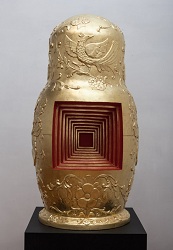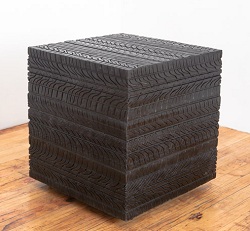
Innovative artist Arcady Kotler is not associated with any particular creed, religion, or tradition, but excludes none. At the core of his works lies a profound sense of intimacy that hopefully initiates a dialog, for which the artist always longs. Kotler's work presents the evolution of a concept bearing form: from elaborately adorned yet impeccably harmonious ("Clothed Maja") to minimalist, with a strong reference to Russian supremacy; in "The Red Square" [left], the rigid geometry of a square intrudes on the organic form of the intentionally excessively decorated Russian nesting doll. It feels as if complexity has reached its limit and collapsed into the simplicity of the red square.
A matryoshka is a traditional Russian toy, the skill level of which rests on the number of nesting dolls it consists of. The last and smallest doll of Arcady's matryotshka is not hollow. It is solid. The artist refers to this as a point of singularity. His matryoshka is infinite. Cross-sectioned by a square, it allows an imaginary "zoomed" view inside, towards an ephemeral point of singularity, where nonexistence becomes reality, where matter is reborn.
Why does the artist choose to gold plate his work? Does this not contradict the idea expressed in his artist statement: "I'm drawn to lightweight and widely available materials of negligible value"? It still holds true. The gold serves the purpose of acknowledging Kotler's Russian heritage. The associative sequence could be the following: just as the tolling, an acoustic climax of transcendence, is born of a cathedral's golden dome, the red square, a visual realization of such, emerges out of the golden dome-shaped womb of the matryoshka.
Another perspective for using gold could also be offered. If we step aside and look at Arcady Kotler's exhibition as a whole, a parallel can be drawn between the assembling of the works, arranging the space, and building a temple. A massive wooden skeleton -- the base of construction, white stucco or alabaster -- its body, and finally the golden finish of the dome; every material is present to establish and support a beautiful and harmonious structure.
It is not a stretch to say that, surrounded by the artist's works, one can experience a sense of spiritual elevation and conscious awareness reminiscent of being in a temple. Consciousness manifested through matter is a motif in his art. The artist dwells on the symbolism of the shapes, such as a square and a circle. A white circular puzzle is as perfect as it is fragile. It cannot be reassembled once destroyed; it's symbolic of the preciousness and fragility of life.
 Another circle is "Sewer," made out of sugar cubes. This is how the artist explains the concept behind this work: "I contemplate my cube as innate knowledge of a perfect form with negligible entropy. Man-constructed reality is a world of straight angle structures that help sustain life and shelter us from entropy. They mimic the rigid geometry of an ideal crystal. A round sewer is a gate to the world of decay, decomposition and disintegration where entropy takes over.
Another circle is "Sewer," made out of sugar cubes. This is how the artist explains the concept behind this work: "I contemplate my cube as innate knowledge of a perfect form with negligible entropy. Man-constructed reality is a world of straight angle structures that help sustain life and shelter us from entropy. They mimic the rigid geometry of an ideal crystal. A round sewer is a gate to the world of decay, decomposition and disintegration where entropy takes over.
"I have chosen a sugar cube as a structural unit for the sewer because it possesses a certain duality: it is a man made material that reflects the building block of an urban landscape. Yet it is designed to quickly dissolve and disintegrate with entropic quality inbuilt and reinforced in it."
 Kotler's sculpting medium is dictated by the concept, or as in "Sugar Mine," the medium itself becomes the object of art. He displays an enormous sugar rock, puzzling the viewers by its origin and artificiality. The artist suggests an unusual point of view on the artificial versus the natural. In totality, all matter is shaped by universal laws or consciousness. Consciousness, manifested through human form, shapes matter "artificially." At the end, though, the essence of humanity lies within the realm of the "natural," and regardless of its seemingly destructive or even self-destructive nature, the big picture still looks as bright as a huge, sweet, and shiny sugar rock!
Kotler's sculpting medium is dictated by the concept, or as in "Sugar Mine," the medium itself becomes the object of art. He displays an enormous sugar rock, puzzling the viewers by its origin and artificiality. The artist suggests an unusual point of view on the artificial versus the natural. In totality, all matter is shaped by universal laws or consciousness. Consciousness, manifested through human form, shapes matter "artificially." At the end, though, the essence of humanity lies within the realm of the "natural," and regardless of its seemingly destructive or even self-destructive nature, the big picture still looks as bright as a huge, sweet, and shiny sugar rock!
Similar in optimistic perception of the art work, the following poem, cheerfully recited by an eccentrically looking kid at the exhibition, is published below with his permission:
 Another crowd-gathering piece is the cube-shaped "Flat Tire," the popularity of which is explained by the element of surprise and its rather dominant, space-claiming appearance. Some peculiar play on abbreviations, such as Dual Meaning Tire or DMT or Dimethyltryptamine (a powerful chemical naturally occurring in humans), comes to mind when describing this work. Just as DMT alters one's consciousness and the perception of reality, the square tire, with its essential dynamic quality removed, suggests the transcendence of consciousness into the state of stillness and clarity.
Another crowd-gathering piece is the cube-shaped "Flat Tire," the popularity of which is explained by the element of surprise and its rather dominant, space-claiming appearance. Some peculiar play on abbreviations, such as Dual Meaning Tire or DMT or Dimethyltryptamine (a powerful chemical naturally occurring in humans), comes to mind when describing this work. Just as DMT alters one's consciousness and the perception of reality, the square tire, with its essential dynamic quality removed, suggests the transcendence of consciousness into the state of stillness and clarity.
The works made of rope are objects from childhood. They bring feelings of vulnerability and intimacy to the scene. The artist tries to prolong the moment of fragile balance of the swings and a jump rope between ascending and descending, symbolic of transcendence between existence and non-existence, chaos and zero entropy, spacelessness, oblivion, and ultimate clarity.
The opening of Arcady’s exhibition was postponed by Hurricane Sandy. Sandy gave a new meaning to the name of the show, Sculpting the Void. Was the artist sculpting the void left in people’s minds and lives by the terrifying winds and waves? Was he channeling the forces of rebirth? What can be concluded with confidence is that the timeless content of Kotler’s works allows them to withstand the challenge of being viewed through the prism of a disaster's aftermath and perceived as art of great significance.
